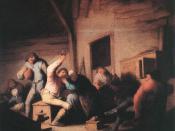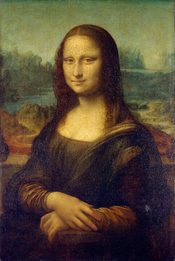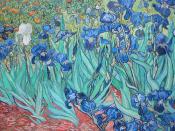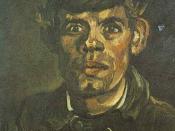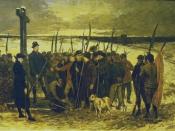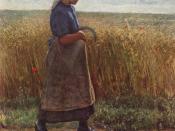Vincent Van Goph " An artists work changes overtime and its often closely bound to the artists life"ÃÂ For Vincent Van Goph this is very true, his work changed dramatically over the ten years that he was painting, from dark, realistic drawings of peasant life in charcoal, to light coloured work of close friends and cafes, to the built up richly colourful works in oil paintings. As his life moved from place to place, and his moods changed, so to did his work. In the Borinage, in Belgium, where he was fanatical about the Christian faith and the teachings of the bible, he drew dark, rough drawings of the hardship and toil that the peasant life was. He was incredibly serious and fanatical at that time in his life. When he moved to Paris, and discovered the paintings of other artists, and the bright city, with all its colour and joy, his paintings became colourful, light happy paintings, of friends, cafes, restaurants, no longer the intense, depressing paintings that he used to do.
So his painting style changed dramatically over the years, as he moved around, and faced trials in life.
When Van Goph first started to draw and paint, he was living in the south of Belgium, in the borinage. He was a preacher, and evangelist, a fanatical about the church, who took the teachings of the bible seriously and literally, and this angered the clerics, and frightened the people who he was trying to help. Van Goph was a very compassionate man who love human kind, yet he had the unfortuance of not being able to communicate well. So, he turned to art, in which he could poor out his feelings, and show the hardship that the peasants faced.
In these first drawings that he did, he wanted to show the peasant life as it was, a hardship and struggle that the people faced everyday, the continual weary struggle day after day. So naturally, these drawings were done in black charcoal and dark paints, very serious drawings which reflected the mood Van Goph was in, he also empathised features of the peasant, the hands were often painted bent, knobbly, old crippled, the tell tale signs of hard labour. The faces were often exaggerated to show sunken cheeks, world-weary eyes, almost deformed looking. Often though, he wouldn't show faces, as he wanted to try to show the person representing all of the peasants, not on a personal level. Van Goph was trying to get across the struggles that they faced. They reflected his depression at the life that the peasants went through, he was living everyday seeing the people struggling to make a living, in the mines, from dusk till dawn everyday, and the effects showed through in his paintings.
After deciding that his mission in life was art, Vincent left Belgium and went to Brussels, then to his family home, where he proceeded to have his second disastrous encounter with women, a young widow named Kee, who rejected him, after he chased her frantically. This experience made Vincent long for human warmth and love, which he craved, and he then fell in love with a prostitute name Sien, who also ended up rejecting him.
After these unfortunate incidents, Van Goph moved to Paris, where he discovered a world of literature, music, and art. More importantly, Japanese wood block prints, which influenced his work greatly. After being exposed to other artists, his work began to change, and in two years had done a complete turn about. Gone was the dark depressing drawings, they were now colourful and light, they had a beautiful sense of wellbeing in them. Paris had changed Van Goph, the whole atmosphere, activity, the people, even the weather, it was bursting with activity, warm weather, and gaiety now surrounded him. So he starting doing portraits of friend, in vivid colour.
Van Goph started to experiment using wood block prints, dots of colour that made up the detailed paintings of cafes, and restaurants. So Paris seemed to liberate him and give him the freedom to experiment with his work and the technique's he used. He started to experiment with colour, and the moods and emotions that it invocated, his subjects also changed from peasants, to portraits, flowers, landscapes and still life's.
Unfortunately Van Goph started to change mentally, he became depressed, suffering the rejection of other artists and people, he was a very depressed man. To try to save himself, he left Paris and went to arles. Here he pursed his belief in colour representing emotion and mood, and began to use colour as a representation of emotion. His best works came in this time, Sunflowers is one of them. The detail in this painting is incredible, the use of colour as well, the way he used yellow, a sign of life, friendship, warmth, caring , is all expressed through the detail and colour of this one painting. Van Goph became an expert colourist. In another painting of this time, the harvest, he uses greens, violets, yellow, and blues, tranquil colours which compliment each other, and have a whole aura of well being and peace. He used short, strong brush strokes of colour, which help to define and heighten the difference in the colours.
Soon Vincent's mental health began to deteriorate at an alarming speed, and his paintings reflected this. His paintings started to have sadness about them, a loneliness, which was reflected by the depressing blues and greys that Van Gpoh was using in his paintings. One of these extremely sad paintings was the wheat fields with crows, a painting with a depressing, foreboding sky, painted in short, strong brush stokes, which added to the element of confusion and despair, which echoed Van Gophs state of mind, and his loneliness, the rejection he felt from the human race.
Van Gophs last self portrait showed the sorrow and depression that he felt everyday. The painting was done incorporating the depressing and sad tones of blue, which was in the back ground in swirls and twists, echoing the befuddled state of his mind, the questions, his eyes wide and piercing, gaunt sunken cheeks and the blue suit he was wearing. The whole painting echoed his pain and loneliness. Van Goph was a very depressed man, and it showed at the end through his paintings.
